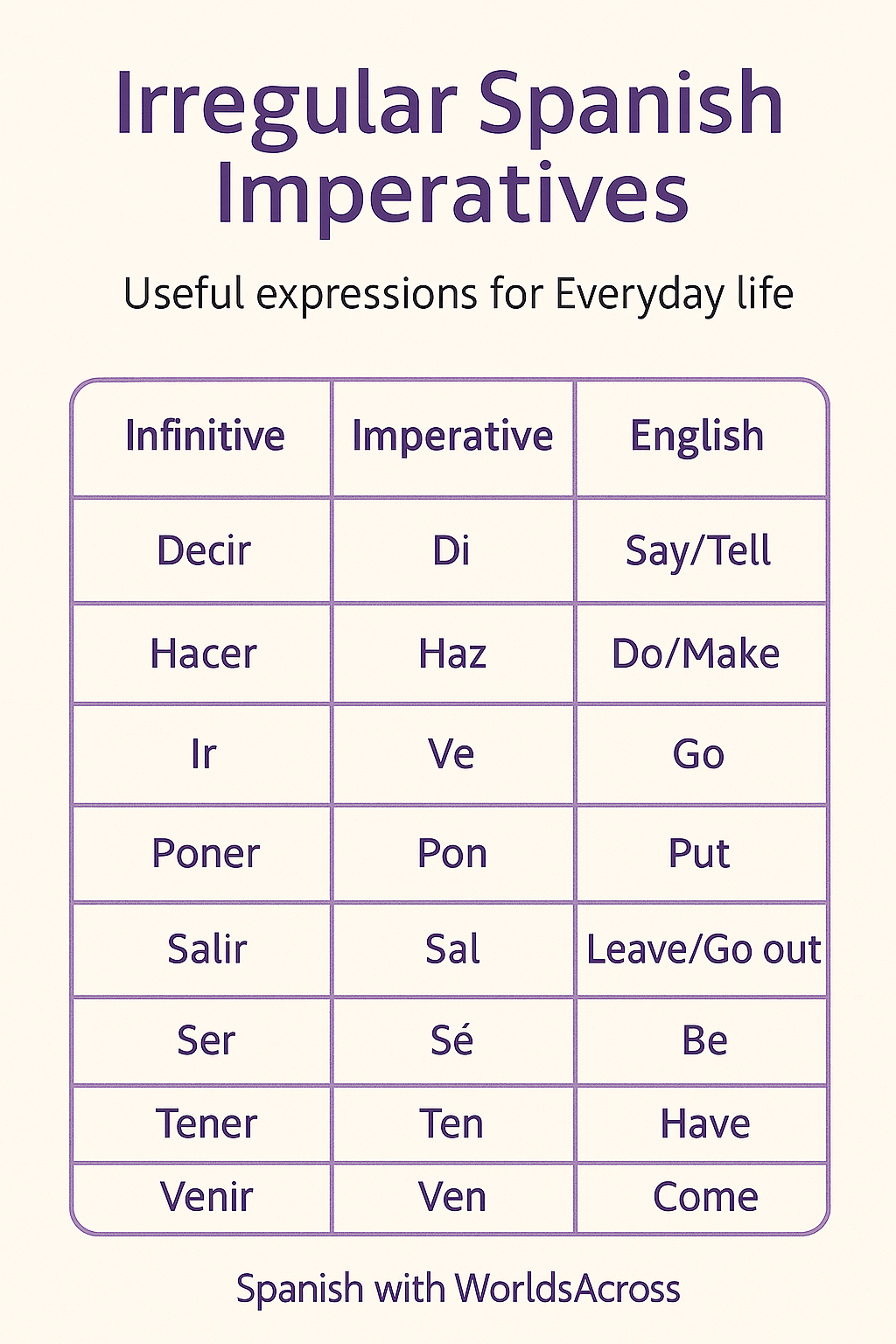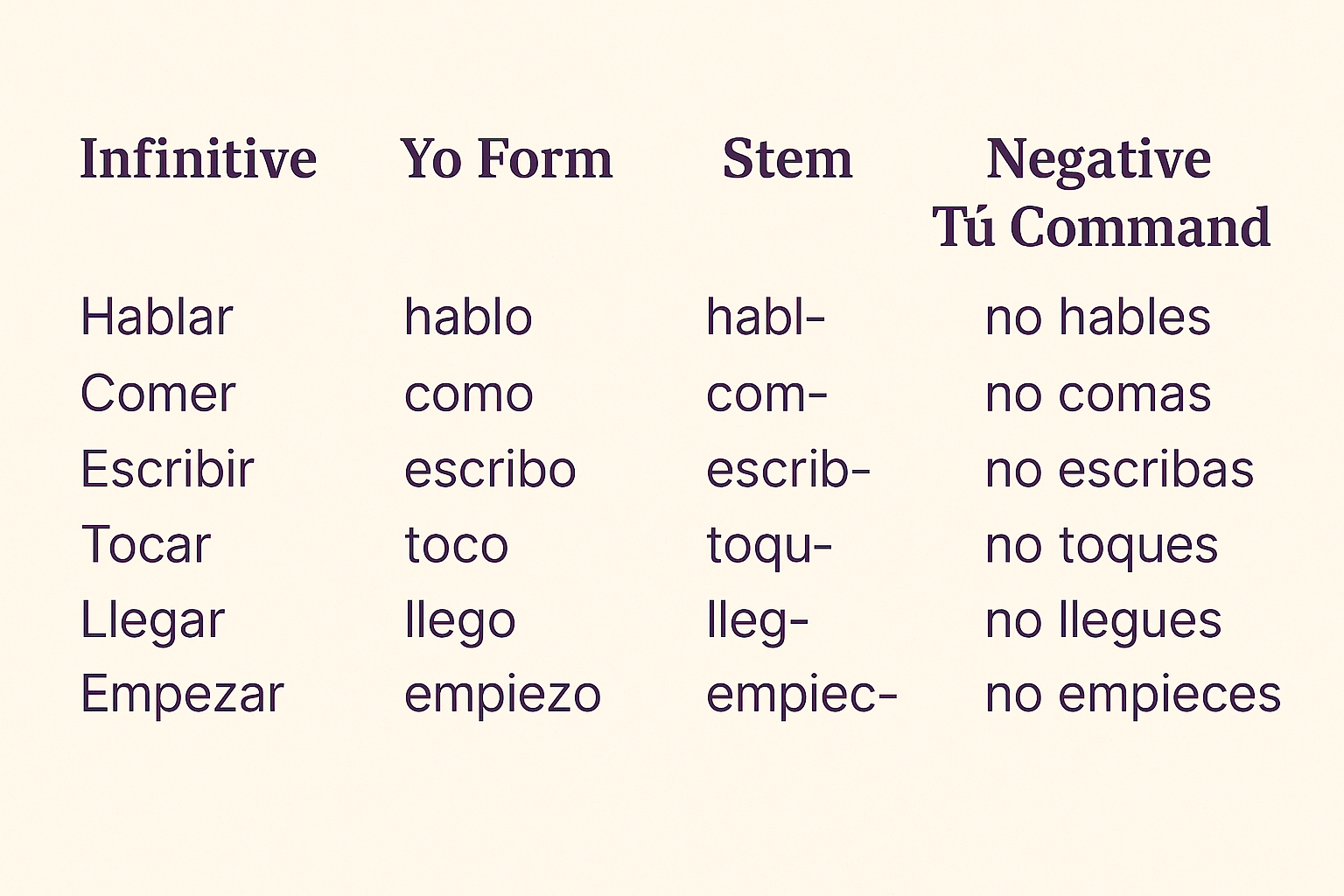How to use the imperative in Spanish to give orders or advice?
One sounds like a hobby. The other sounds like a command your Spanish teacher might shout with love and determination. Don’t worry -nobody’s yelling at you here-. We’re just diving into one of the most fun and useful parts of Spanish grammar: the imperative mood.
Whether you want to ask your friend to pass the guacamole politely, or you need to shout “Run!” (¡Corre!) As a mariachi band chases you down the street (hey, it could happen), knowing how to use the imperative in Spanish will make you sound more fluent and confident.
In this guide, we’ll cover how to give orders in Spanish, how to form the imperative for beginners, and we’ll sprinkle in plenty of imperative in Spanish examples so you can practice along the way.
What Is the Imperative Mood?
Let’s keep it simple: The imperative is the “command form” of a verb. You use it when you want someone to do something. You’re not talking about doing something in general, you’re telling them to do it.
Here are a few situations where you might use the imperative in Spanish:
- To give an order: Cierra la puerta (Close the door)
- To make a suggestion: Escucha esta canción (Listen to this song)
- To give advice: Habla con tu tutor (Talk to your tutor)
- To make a polite request: Manda el correo, por favor (Send the email, please)
So yes, the imperative can sound a little bossy. But it’s also one of the most versatile tools in your Spanish toolkit. Once you learn how to use it, you'll hear it everywhere, songs, ads, conversations, and yes, even the occasional telenovela.
Start Simple: The “Tú” Form of the Imperative
If you’re just starting, the best place to begin is with the imperative for “tú” (you, informal singular). This is the form you’ll use most often with friends, siblings, or anyone you’re familiar with.
The Rule:
To form the affirmative tú command, take the verb and use the 3rd person singular (él/ella) form in the present tense.
Yes, it’s that easy!
Let’s look at a few Spanish imperative verbs in action:
- Caminar (to walk)
Tú caminas → Él camina → Imperative: ¡Camina!
(Walk!)
- Estudiar (to study)
Tú estudias → Él estudia → Imperative: ¡Estudia!
(Study!)
- Comer (to eat)
Tú comes → Él come → Imperative: ¡Come!
(Eat!)
- Escribir (to write)
Tú escribes → Él escribe → Imperative: ¡Escribe!
(Write!)
These simple endings will help you learn the imperative for beginners:
- AR verbs: change to -a (like habla, camina, estudia)
- ER / -IR verbs: change to -e (like come, escribe, corre)
Try them out yourself! Want your friend to sing? Tell them: ¡Canta!
Want them to run? ¡Corre!
See? You’re already commanding in Spanish!
Imperative in Span ish Examples: Real-Life Uses
Let’s go beyond the basics and look at some everyday examples of the use of the imperative in Spanish:
Giving Friendly Advice:
- Estudia este tema para mañana. (Study this subject for tomorrow.)
- Come el desayuno todos los días. (Eat breakfast every day.)
- Escribe una carta para tu abuelo. (Write a letter to your grandfather.)
Giving Orders (with a smile!):
- Lávate las manos. (Wash your hands.)
- Apaga la luz. (Turn off the light.)
- Ven aquí. (Come here.)
Making Suggestions:
- Prueba este plato típico. (Try this traditional dish.)
- Mira esa película, te va a encantar. (Watch that movie, you’ll love it.)
The tone of your voice -and your choice of words- can turn a command into a kind suggestion or a gentle nudge. Add a “por favor” and you’re golden.
A Quick Word on Irregular Imperatives
Just when you were getting comfortable, Spanish throws a curveball: irregular verbs. These don’t follow the usual rules, but they’re super common, so it’s worth learning them early.
Here are some of the most common irregular Spanish imperative verbs in the tú form:

Examples:
- Haz tu tarea. (Do your homework.)
- Pon la mesa. (Set the table.)
- Sé amable. (Be kind.)
- Ven aquí. (Come here.)
They might take a little memorization, but you’ll see these so often that they’ll stick naturally.
Saying “Don’t”: Negative Commands in Spanish
So you’ve got the hang of telling people what to do in Spanish — now let’s learn how to tell them what not to do. Whether you're trying to stop your little brother from touching your stuff or telling your friend not to skip Spanish class (¡No lo hagas!), knowing how to form negative commands is essential.
How to Form Negative Tú Commands
Negative commands in Spanish follow different rules from affirmative ones. Here’s the step-by-step:
- Start with the “yo” form of the verb in the present tense.
- Drop the -o ending.
- Add the opposite ending:
- For -AR verbs, add -es
- For -ER/-IR verbs, add -as
- Put “no” in front of the verb.
Examples:

Notice the small spelling changes in verbs like tocar (to touch) or empezar (to begin), these are there to preserve pronunciation.
With Reflexive and Object Pronouns
When using reflexive verbs or pronouns (like te, lo, me, nos), they go before the verb in negative commands.
- ¡No te levantes! - Don’t get up!
- ¡No lo hagas! - Don’t do it!
- ¡No me digas! - Don’t tell me!
In contrast, with positive commands, the pronouns go at the end (e.g., ¡Levántate!).
Learning how to give orders in Spanish might sound like the key to becoming a bossy travel buddy, but really, it’s a gateway to more confident communication. Whether you’re asking for help, giving directions, or just encouraging your friend to sing karaoke (¡Canta!), the imperative is a powerful tool.
So next time someone asks you “¿Cómo se usa el imperativo en español?”, you can smile and say:
“¡Escucha y aprende!” (Listen and learn!)
And if you’re ready to keep going, drop a comment below and tell me what you’d like to learn next: There’s always more Spanish fun to be had.


